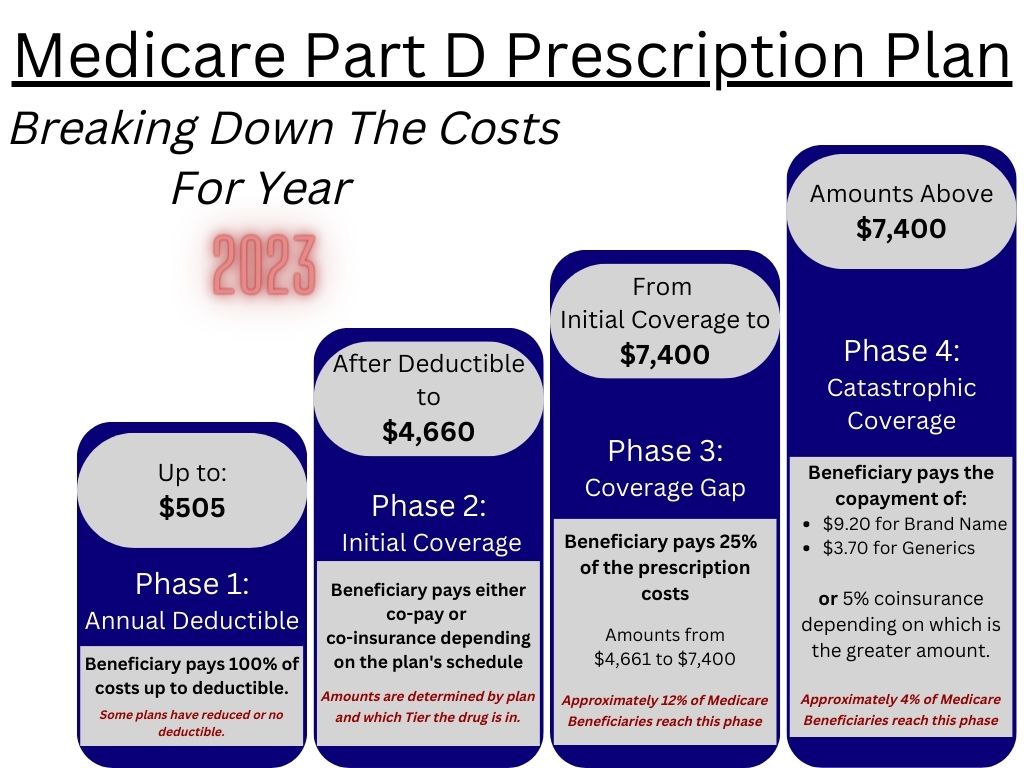The Inflation Reduction Act has lots of parts that help make prescription drugs more affordable, including closing the “donut hole” and changing how much money you have to pay when getting your prescriptions through this drug plan.
So if you’re on Medicare donut hole or know someone who is, now you know a bit more about how the Inflation Reduction Act helps people save money when it comes to prescriptions – including closing the dreaded Medicare donut and making sure there’s Medicare drug coverage. This way, people with Medicare coverage can get the medicines they need without breaking the bank.
If you’re dealing with the Medicare donut hole or using Medicare D, now you know a bit more about how the Inflation Reduction Act can help with donut hole coverage.
Part 1: Overview of the Medicare Part D Benefit in 2023
To comprehend the changes and donut hole explanation, let’s first understand how prescription drug coverage, and the Medicare Benefits work. The Medicare D benefit has four distinct phases, determining the share of prescription drugs paid by enrollees, Medicare Part D plans, drug manufacturers, and Medicare coverage. Here’s a breakdown of each phase:
1. Deductible Phase: The Medicare donut phase starts when enrollees pay 100% of their drug coverage costs, up to $505 in 2023. Some Medicare Part D plans don’t charge a deductible, under their prescription drug coverage, but most stand-alone plans do.
2. Initial Coverage Phase: During the Medicare donut hole phase, enrollees pay 25% of total costs, while Medicare D plans cover the remaining 75%, up to $4,660 in 2023. People commonly use copayments and coinsurance in this coverage gap Medicare phase.
3. Medicare Coverage Gap Assistance Phase (Donut Hole): The Medicare donut hole continues as enrollees pay 25% of total costs, including both brand-name and generic drugs. This Medicare Part D plan pays 75% of generic drug costs, 5% of brand-name costs, and drug manufacturers provide coverage gap assistance and a 70% price discount on brands.
4. Catastrophic Phase: The Medicare donut enters its final phase as Medicare pays 80%, while the Medicare D plan pays 15%. You will be responsible for paying 5% of the total cost. If your out-of-pocket expenses, plus any donut coverage on brand-name drugs offered by the manufacturer, add up to more than a certain amount, you may qualify for catastrophic Medicare drug coverage. This means that you won’t have to pay as much and your Medicare coverage can help cover some or all of your remaining costs.

Part 2: Changes Coming in 2024
In 2024, several Medicare donut hole and Medicare D modifications will be implemented to improve the Medicare drug coverage benefit:
1. Elimination of 5% Coinsurance: In this Medicare drug coverage enrollment, specific thresholds determine the amount of money you will have to pay out of pocket for your prescription drugs. Beginning in 2024, the threshold for reaching catastrophic coverage is $8,000. This means that if your total drug costs for a single year hit or exceed this amount, you essentially cap them at $8,000, and don’t need to pay any additional amount. Additionally, before reaching the catastrophic coverage phase, enrollees no longer need to cover 5% of their drug costs as they previously did – they have eliminated this requirement. This change ensures that no one enrolled in this plan has to worry about paying too much for their medications during a single year.
2. Increased Plan Contribution: This Medicare Plan D plan will now be required to pay 20% of total drug costs in the catastrophic phase, up from 15% in previous years.
Part 3: Changes Coming in 2025
As prescription drug coverage evolves, the Medicare donut hole and Medicare D benefit will introduce these changes in 2025:
1. Out-of-Pocket Spending Cap: When you enroll, the amount of money that you will have to pay for your medications out of your own pocket each year is limited to $2,000. This means that no mater how much your medicines cost, you will never have to pay more than $2,000. Every year, this limit might change based on the average cost of medicines for everyone. That way, the limit stays up to date with how much medications cost and you can still get the help that you need.
2. Elimination of Medicare Coverage Gap Assistance Phase: The Medicare coverage gap assistance phase, where enrollees faced 100% of their drug costs, will be eliminated in 2025. Enrollees will no longer experience a change ni their cost sharing when transitioning from the initial coverage phase.
3. Adjustments in Cost Sharing: Medicare Donut Hole Part D plans will help cover the costs of your prescription drugs when they reach a certain amount. When your costs get very high, these plans will pay 60% of what you owe, and the drug companies will reduce the cost of their brand-name medicines by 20%. Before your costs get too high, these plans will still help out – they’ll pay 65% of the cost, and drug companies will reduce the price of their brand-name drugs by 10%. That way, you can get the medicine you need without spending too much.
Part 4: Additional Changes to Part D

1. Affordable Insulin: Starting in 2023, insulin costs will be capped at $35 monthly for all Medicare Part D plans, helping reduce Medicare drug coverage expenses.
2. Vaccination Medicare drug Coverage: The Medicare donut and prescription drug coverage plans will cover adult vaccines without cost sharing, expanding Medicare coverage benefits.
3. Full Benefits for Low-Income Individuals: Beginning in 2024, individuals with incomes up to 150% of the poverty level will be eligible for full benefits under the Part DLow-Income Subsidy (LIS) Program. The act will eliminate the partial LIS benefit for individuals with incomes between 135% and 150% of the poverty level.
4. Premium Adjustments: Starting in 2024, the amount of money that people on Medicare have to pay each year will not be allowed to go up by more than 6%. This means if it goes up at all, it can only go up by a maximum of 6%.
Part 5: Medicare Part D Improved Out-of-Pocket Costs
Starting in 2025, all Medicare donut hole enrollees will have the option to spread out costs over the year instead of facing high Medicare coverage gap assistance expenses in particular months.
What Is Medicare Part D?
While Medicare provides medical coverage for people over 65, Medicare Part D plans are administered through private insurers, helping address the Medicare donut hole challenge.
You will be responsible for enrolling in a drug coverage program once you reach the age of 65 and/or enroll in Medicare Part A or Part B.
Do I Have to Enroll in a Medicare Part D Prescription Drug Plan?
Understanding The 4 Phases of Medicare Part D Prescription Plans
Prescription drug coverage operates through several stages:
1. Deductible Phase: You must pay the full deductible, up to $505 in 2023.
2. Initial Coverage Phase: You make copayments until drug costs reach $4,660.
3. Medicare Coverage Gap Assistance (Donut Hole) Phase: You pay 25% of drug costs until out-of-pocket expenses reach $7,400.
4. Catastrophic Coverage Phase: Begins after exiting the Medicare coverage gap assistance.
Medicare Advantage & Part D Prescription Drug Plans Medicare Advantage (MA) plans offer an alternative to traditional Medicare by providing Part A, B, and D benefits through private insurance companies.
It’s important to note that Medicare Advantage plans are distinct from Medigap plans. While Medigap plans supplement Original Medicare, MA plans replace it entirely. When considering Medicare Advantage, keep in mind that you must use a network to maximize your benefits, unlike original Medicare with a Medicare Supplement where you have open access to any provider that accepts Medicare.
How have the Medicare donut hole coverage regulations changed for 2023?
What is the donut hole coverage?
Is the Medicare Donut Hole coverage closing?
What if I get extra help for Medicare Part D?
For full extra help: No deductible, no premium, and reduced copayments for drugs.
For partial extra help: Reduced premium, lower deductible, and 15% coinsurance for prescriptions.
Starting in 2024, more people will qualify for full extra help, including those who currently meet partial extra help income caps.
Conclusion:
The Inflation Reduction Act of 2022 is making changes that will help make prescription drugs more affordable for people with Medicare and prevent them from falling into the notorious medicare donut hole part . It sets a limit on how much you can have to pay out-of-pocket, ensuring your costs won’t be as high.
Additionally, it eliminates the Medicare coverage gap assistance in coverage, so you won’t have to put up with full price for medications when they are most needed. Finally, they are changing the way we share the cost of medicines. This means both Medicare and you will contribute less money towards medicine costs, providing relief al around. By implementing these changes, the Act aims to reduce healthcare disparities and ensure access for everyone.
The Medicare donut hole coverage part D is an issue that the Inflation Reduction Act of 2022 seeks to mitigate. People with Medicare donut hole will find prescription drugs more affordable due to its changes, and they wont’ have to worry about falling into the Medicare donut hole part D.


